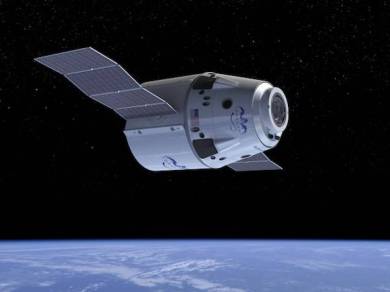
Adobe Acrobat document [1.1 MB]
United Nations Conference on Disarmament - Geneva
MUSIS - Multinational Space Based Imaging System
SPOT - Satellite Pour l'Observation de la Terre
National Environmental Satellite, Data, and Information Service (NESDIS)
Commercial Remote Sensing Regulatory Affairs Office (CRSRAO)
Commercial Remote Sensing Compliance and Monitoring Program (CRSCMP)
National Space Policy of the US - 2010
National Space Policy of the US - 2006
National Security Space Strategy - 2011
Inter-Agency Space Debris Coordination Committee (IADC) Space Debris Mitigation Guidelines - 1993
The Inter-Agency Space Debris Coordination Committee (IADC) is an international forum of governmental bodies for the coordination of activities related to the issues of man-made and natural debris in space. The primary purpose of the IADC is to exchange information on space debris research activities between member space agencies, to facilitate opportunities for co-operation in space debris research, to review the progress of ongoing co-operative activities and to identify debris mitigation options.
Members of the IADC are the Italian Space Agency (ASI), British National Space Centre (BNSC), Centre National d’Etudes Spatiales (CNES), China National Space Administration (CNSA), Deutsches Zentrum fuer Luft-und Raumfahrt e.V. (DLR), European Space Agency (ESA), Indian Space Research Organisation (ISRO), Japan, National Aeronautics and Space Administration (NASA), the National Space Agency of Ukraine (NSAU) and Russian Aviation and Space Agency (Rosaviakosmos).
One of its efforts is to recommend debris mitigation guidelines, with an emphasis on cost effectiveness, that can be considered during planning and design of spacecraft and launch vehicles in order to minimise or eliminate generation of debris during operations. This document provides guidelines for debris reduction, developed via consensus within the IADC.
The leading text on space law is "The Laws of Spaceflight" by Matthew Kleiman, Jenifer Lamie, and Maria-Vittoria "Giugi" Carminati. It is available from the ABA. Kleiman also teaches a class on space law at Boston University.
Noteworthy links while reading the book:
Vienna Convention on Law of Treaties
Committee on the Peaceful Uses of Outer Space (COPUOS)
International Telecommunications Union
Red lines in outer space by Matthew Kleiman and Sonia McNeil
1947 Armed Services Procurement Act
1949 Federal Property and Administrative Services Act
1949 Coordinating Committee for Multilateral Export Controls (CoCom)
1958 National Aeronautics and Space Act (Unamended)
1958 National Aeronautics and Space Act (Amended)
1962 Communications Satellite Act (Comsat Act)
The Outer Space Treaty turns 50. Can it survive a new space race?
1970 Treaty on the Non-Proliferation of Nuclear Weapons and updates
1972 Anti-Ballistic Missile (ABM) Treaty
1972 Convention on International Liability for Damage Caused by Space Objects
1974 Office of Federal Procurement Policy Act
1975 Convention on Registration of Objects Launched into Outer Space
1979 Agreement Governing the Activities of States on the Moon and Other Celestial Bodies
1981 Prevention of an Arms Race in Outer Space (PAROS) - and updates
1984 Commercial Space Launch Act
1984 Land Remote-Sensing Commercialization Act
1984 Competition in Contracting Act (CICA)
1992 Land Remote Sensing Policy Act
1993 Chemical Weapons Convention
1994 Presidential Decision Directive 23 by President Clinton
1996 Comprehensive Nuclear Test-Ban Treaty (CTBT)
U.S. Freedom of Information Act
Kyl-Bingaman Amendment - Section 1064 of the Defense Authorization Act of 1997
1998 Intergovernmental Agreement on Space Station Cooperation
2004 Commercial Space Launch Amendments Act (CSLAA)
Virginia's Space Flight Liability and Immunity Act of 2007
2007 Global Exploration Strategy
2007 United Nations Space Debris Mitigation Guidelines
2009 U.S.C. Title 51: National and Commercial Space Programs
Transparency and Confidence-Building Measures in Outer Space
Space Policy - news, information, and analysis about civil, military, and commercial space programs
United Nations Treaties and Principles on Space Law
US Space Legislation and Policies
International Traffic in Arms Regulations (ITAR)
Directorate of Defense Trade Controls (DDTC)
Orbital Debris Reference Documents
The Air and Space Lawyer Online
International Institute of Space Law
National Center for Remote Sensing, Air, and Space Law
ABA SciTech Space Law Committee
Federal Acquisition Regulations (FAR)
General Services Administration (GSA)
Defense Federal Acquisition Regulation Supplement (DFARS)
FAA Rules on Commercial Space Transportation
Office of Commercial Space Transportation
Efficient Use Policy and Open Skies Policy
Telecommunications CFRs - Title 47
Export Administration Regulations (EAR)
Bureau of Industry and Security (BIS)
Office for Foreign Assets Control (OFAC)
Section 38 of the Arms Export Control Act (AECA)
Electronic Export Information (EEI)
National Industrial Security Program Operating Manual (NISPOM)
Export Control Classification Number (ECCN)
Directorate of Defense Trade Controls (DDTC)
Destination Control Statement (DCS)
Defence Security Service (DSS)
Manufacturing License Agreement (MLA)
Missile Technology Control Regime (MTCR)
Significant Military Equipment (SME)
Special Export Controls (SECs)
FAR 33 - procedures for protests
Allowable Cost and Payment Clause (FAR 52.166-7)
Cost Accounting Standards (CAS)
FAR 52.250-1 Indemnification under Public Law 85-804
Boyle v. United Technologies Corp - 487 U.S. 500 (1988)
National Industrial Security Program (NISP)
National Environmental Policy Act (NEPA)
Interagency Nuclear Safety Review Panel (INSRP)
Center for Space Standards and Innovation (CSSI)
Satellite Orbital Conjunction Reports Assessing Threatening Encounters in Space (SOCRATES)
International Scientific Optical Network (ISON)
Inter-Agency Space Debris Coordination Committee (IADC)
Patent Cooperation Treaty (PCT)
Paris Convention for the Protection of Industrial Property
The World Intellectual Property Organization Copyright Treaty (WCT)
Agreement on Trade-Related Aspects of Intellectual Property Rights (TRIPS)
International Council of Scientific Unions' Committee on Space Research (COSPAR)
2004 Commercial Space Launch Amendments Act (CSLA) - PUBLIC LAW 108–492
Adobe Acrobat document [84.0 KB]
Licensed launch of spaceflight participants for revenue - 51 USC 50905
Paying claims exceeding liability insurance and financial responsibility requirements - 51 USC 50915
Liability insurance and financial responsibility requirements - 51 USC 50914
Chapter 513 - Space Resource Commercial Exploration and Utilization
SpaceX Falcon Heavy - as of today, September 4, 2014 - the world's most powerful rocket
SpaceX Dragon cargo vessel was captured by the International Space Station's robotic arm on May 25, 2012.
It was the first commercial spacecraft to dock with the station.
1965: INTELSAT established the first commercial global satellite communications system.
2009: first major collision between an operational satellite and space debris - Iridium 33/ Cosmos 2251
Adobe Acrobat document [832.8 KB]
Global Navigation Satellite Systems (GNSS): satellite system used to pinpoint the geographic location of a user's receiver anywhere in the world
International Lawmaking Process
- Treaties
- Customary International Law
International Dispute Resolution
- International Court of Justice (ICJ)
- Bilateral Investment Treaties (BITs)
- Permanent Court of Arbitration
4 Methods for making International Agreements in the U.S.
1. Treaties
2. Congressional Executive Agreements
3. Presidential Executive Agreements
4. Treaty-Authorized Executive Agreements
Department of State Circular 175
International Sources of Space Law
5 Major Outer Space Treaties
4 U.N. General Assembly Resolutions
2. U.N. Res. 41/65. Principles relating to remote sensing of the Earth from space
3. U.N. Res. 47/68. Principles Relevant to the Use of Nuclear Power Sources in Outer Space
Types of Government Contracts
FAR 16.2 - Fixed-price contracts
FAR 16.3 - Cost-reimbursement contracts
FAR 16.4 - Incentive contracts
FAR 16.5 - Indefinite-delivery contracts
FAR 16.6 - Time-and-material contracts
CRADA - Cooperative Research and Development Agreement
SAA - Space Act Agreement
Adobe Acrobat document [1.1 MB]
Adobe Acrobat document [1.1 MB]
Adobe Acrobat document [2.5 MB]
Law Offices of Laura Montgomery
The Law Offices of Laura Montgomery publish Ground Based Space Matters.
Ground Based Space Matters is intended to highlight and explore space law and policy issues, and does not constitute or provide legal advice.
FCC’s Proposed New Orbital Debris Rules: Jurisdiction, Duplication, and Indemnification
When did the FAA release a draft rule? In days of yore.
New Executive Order on Space Mining, the Moon Agreement, and Customary International Law
March 2021 - FAA Streamlined Launch and Reentry Rule Takes Effect
July 2023 - FAA Launches Commercial Human Spaceflight Occupant Safety Rulemaking Committee
The FAA launched a rulemaking committee to examine the development and cost of possible future regulations for commercial human spaceflight occupant safety. The agency is taking this action due to the increase in commercial space activities and the impending end of the Congressional prohibition on commercial human spaceflight regulations in October 2023.
The committee is expected to gather recommendations from industry and other stakeholders to help the FAA plan, conceive, and implement—when the time is right—a well-informed, thoughtful, regulatory regime for commercial human spaceflight occupant safety. Recommendations will be submitted to the FAA next summer.
The committee is co-chaired by Dr. Minh Nguyen, Executive Director of the FAA Office of Commercial Space Transportation and Dr. Mary Lynne Dittmar, Chief Government and External Relations Officer of Axiom Space. View the full membership list here.
Under current federal law, the FAA cannot regulate the safety of individuals on board a space launch or reentry vehicle absent death, serious injury, or a close call. Congress first imposed this regulatory learning period in 2004, and subsequently extended it, to ensure the industry had ample time to grow and innovate.
Presently, FAA regulations require crew and spaceflight participants are made aware of the hazards of space travel and fly under a written informed consent framework.
In addition to this rulemaking committee, the FAA is updating its recommended practices for commercial human spaceflight occupant safety, working with various organizations to develop voluntary consensus standard and conducting or facilitating human spaceflight research.
Back in the Day: The Outer Space Treaty During War -
Laura Montgomery
Jul 24, 2023
Have you ever wondered whether the Outer Space Treaty applies during war? We have some clues from the past to suggest it does not. The Senate held full hearings on the treaty before ratifying it, so there is lots of testimony from the treaty's U.S. negotiators.
The Outer Space Treaty’s applicability provision at Article XIII states that “The provisions of this Treaty shall apply to the activities of States Parties to the Treaty in the exploration and use of outer space, including the moon and other celestial bodies, …” If the Treaty applies only to “exploration and use” it may be argued that neither of those activities include war, although a broader interpretation might view war as a “use.” However, General Wheeler, then Chairman of the Joint Chiefs of Staff, testified to the Senate during the 1967 ratification hearings that the Treaty would not apply during war.
The Department of Defense's Office of the General Counsel later provided a fuller explanation in 1999 and as updated in 2002:
During an international armed conflict between the two nations concerned, however, the law of armed conflict would apply unless it was trumped by the principle of noninterference with space systems. Resolution of this issue depends largely on whether the four space treaties will be considered to apply during an armed conflict. None of them has any specific provision that indicates whether the parties intended that the agreement apply in wartime. There appears to be a strong argument that the principle of noninterference established by these agreements is inconsistent with a state of hostilities, at least where the systems concerned are of such high military value that there is a strong military imperative for the adversary to be free to interfere with them, even to the extent of destroying the satellites in the system. As indicated in the discussion of treaty law in the introduction to this paper, the outcome of this debate may depend on the circumstances in which it first arises in practice. Nevertheless, it seems most likely that these agreements will be considered to be suspended between the belligerents for the duration of any armed conflict, as least to the extent necessary for the conduct of the conflict.
In short, the U.S. Department of Defense seems unlikely to apply the strictures of the Outer Space Treaty during an armed conflict. The DOD position does not appear to have changed as of the 2016 DOD Law of War Manual, which states in reliance on the 1999 assessment quoted above: “Certain provisions of these treaties may not be applicable as between belligerents during international armed conflict.”
Contact Me
Sarah Nilsson, J.D., Ph.D., MAS
602 561 8665
You can also fill out my
Get Social with Me
Legal Disclaimer
The information on this website is for EDUCATIONAL purposes only and DOES NOT constitute legal advice.
While the author of this website is an attorney, she is not YOUR attorney, nor are you her client, until you enter into a written agreement with Nilsson Law, PLLC to provide legal services.
In no event shall Sarah Nilsson be liable for any special, indirect, or consequential damages relating to this material, for any use of this website, or for any other hyperlinked website.
Steward of
I endorse the following products
KENNON (sun shields)












